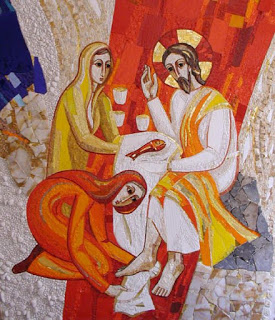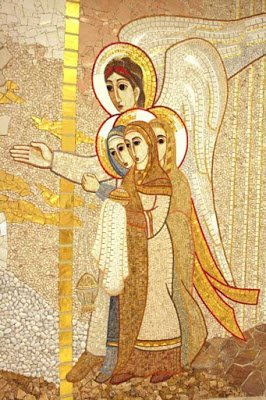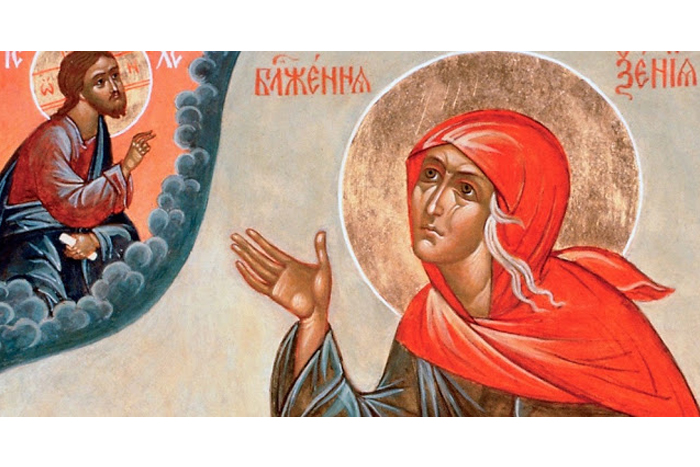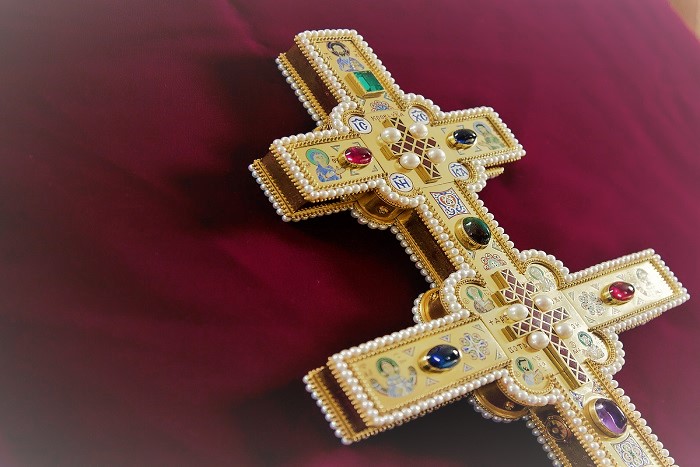Who is commemorated the 3rd Sunday of Pascha? Name ALL the names.
The Church commemorates seven myrrh bearing women on the third Sunday of Pascha: Mary Magdalene, Mary, another Mary, Martha, Salome, Joanna, Susanna, as well as Righteous Joseph of Arimathia and Nicodemus.
Who was the myrrh bearer who was the mother of two of the apostles?
Salome was the daughter of St. Joseph the betrothed, the wife of Zebedee, and the mother of the holy apostles James and John.
One of the myrrh bearers was married to one of the seventy apostles, who saw the risen Lord Before the eleven. Who was she, and who was her husband?
Mary was the wife of Cleophas, as the Holy Evangelist John reports: “Now there stood by the cross of Jesus his mother, and his mother’s sister, Mary the wife of Cleophas, and Mary Magdalene”. (John 19:25). He was a brother of St. Joseph the betrothed, and, along with St. Luke, met Jesus on the day of the resurrection, while on the way to Emmaus. This incredible story is recounted in the 5th matins gospel: Luke 24:12-35, (number 113 according to the Russian Gospel numbering). After long enlightening discourse with Him, they finally recognized him after he broke bread and blessed it.
Which 2 myrrh bearers were sisters?
Mary and Martha, whose brother was Lazarus.
One myrrh bearer was demon possessed and cured by Christ. Who? How many devils? What Pascha tradition is she responsible for?
Mary Magdalene was formerly possessed by seven devils (demons):
“… And certain women, which had been healed of evil spirits and infirmities, Mary called Magdalene, out of whom went seven devils…” (Luke 8:2)
St. Mary Magdalene showed a red egg to a Roman Emperor as proof of the power of Christ, and to this day, it is traditional to have red eggs at Pascha.
What was the contribution to the burial of Christ of the men commemorated today?
The Righteous Joseph obtained the body of Jesus, and along with Nicodemus, anointed Him as best they could and buried him in a tomb that Joseph had intended for himself.
“When the even was come, there came a rich man of Arimathaea, named Joseph, who also himself was Jesus’ disciple: He went to Pilate, and begged the body of Jesus. Then Pilate commanded the body to be delivered. And when Joseph had taken the body, he wrapped it in a clean linen cloth, And laid it in his own new tomb, which he had hewn out in the rock: and he rolled a great stone to the door of the sepulchre, and departed. And there was Mary Magdalene, and the other Mary, sitting over against the sepulchre.” (Matthew 27:57-61)
“And after this Joseph of Arimathaea, being a disciple of Jesus, but secretly for fear of the Jews, besought Pilate that he might take away the body of Jesus: and Pilate gave him leave. He came therefore, and took the body of Jesus. And there came also Nicodemus, which at the first came to Jesus by night, and brought a mixture of myrrh and aloes, about an hundred pound weight. Then took they the body of Jesus, and wound it in linen clothes with the spices, as the manner of the Jews is to bury. Now in the place where he was crucified there was a garden; and in the garden a new sepulchre, wherein was never man yet laid. There laid they Jesus therefore because of the Jews’ preparation day; for the sepulchre was nigh at hand.” (John 19:38-42)
Why were the myrrh-bearing women going to the tomb early Sunday morning? According to the teaching of the fathers and services, what was the nature of their thoughts? Why did they not do this earlier?
The women wanted to anoint the body of Jesus, since they did not have enough time before the Passover began. They were going to the grave to anoint a dead man. They as yet did not understand that He would rise from the dead.
The Gospels mention a “Mary the mother of Joses”, and “Mary the mother of James the less”. Who was this Mary?
According to the witness of the majority of the Fathers, “Mary the mother of James” was none other than the Theotokos. Blessed Theofylact, in his commentary on St. Luke chapter 24 states this quite plainly: “Mary the mother of James is the Theotokos. They gave her this name as the apparent mother of James the son of Joseph, whom also they called James the Younger, that is, the brother of the Lord. For there was also James the Elder, one of the twelve, the son of Zebedee” (Blessed Theofylact, Commentary on St. Luke, Pg. 317). Holy tradition and the gospels place the Theotokos at the cross of Christ, as St. John states:
“Now there stood by the cross of Jesus his mother, and his mother’s sister, Mary the wife of Cleophas, and Mary Magdalene.” (John 19:25)
The Evangelist Mark mentions the mother of God by this other, more cryptic name when he describes those who were near the cross:
“There were also women looking on afar off: among whom was Mary Magdalene, and Mary the mother of James the less and of Joses, and Salome; (Who also, when he was in Galilee, followed him, and ministered unto him;) and many other women which came up with him unto Jerusalem.” (Mark 15:40-41)
The Holy church often refers to the Theotokos quite cryptically, from the old testament prophesies into the New Testament evangelical writings.
As an aside, we take note that Blessed Theofylact wrote his commentary, a compendium of all of the thought of the fathers from Pentecost onwards, in the 11th century. This was well before any impious innovators would suggest that the mother of God, the Theotokos, the ever virgin Mary, had children other than Jesus. The knowledge that the Holy Theotokos was and is a virgin was so fixed in the mind of the church that one could be so bold as to say that one cannot be Orthodox and believe otherwise. The innovations of the Protestants, in reaction against the corruption of the schismatic and later heretical Latins, would not come for many more years. They have much explaining to do if they are to prove that the Theotokos is not ever virgin, when so many prophesies, the testament of the Fathers, and the mind of the church stand as a united witness against their arrogant folly.
What were the women concerned about at that very early hour as they went to the tomb to anoint a dead body. What obstacle was curiously missing from their worried thoughts? What happened? Describe the instructions they were given, and in particular, why a particular apostle was singled out by name?
The women were mostly concerned about the great stone in front of the tomb, and seemed to not even be considering that the tomb was guarded by an elite contingent of soldiers!
“And they said among themselves, Who shall roll us away the stone from the door of the sepulchre?” (Mark 16:3)
They saw the stone rolled away from the tomb, and were met by an angel when they entered it. it:
“And when they looked, they saw that the stone was rolled away: for it was very great. And entering into the sepulchre, they saw a young man sitting on the right side, clothed in a long white garment; and they were affrighted.” (Mark 16:4-5)
The angel told them to tell the apostles, but especially singled out Peter:
“And he saith unto them, Be not affrighted: Ye seek Jesus of Nazareth, which was crucified: he is risen; he is not here: behold the place where they laid him. But go your way, tell his disciples and Peter that he goeth before you into Galilee: there shall ye see him, as he said unto you.” (Mark 16:6-7)
It had only been a few days since Peter had denied Christ three times. He was in a bewildered state, with his conscience pricking him terribly, and needed to be encouraged. A sessional hymn sung in matins expresses what surely must have been Peter’s feelings:
“After Thy Resurrection on the third day / and the act of worship of the Apostles, / Peter called out unto Thee: / “The women ventured while I was afraid; / the thief confessed God while I denied Him. / Wilt Thou continue to call me a disciple? / Wilt Thou not make me again a fisher of the deep? // Rather accept me repenting, O God, and save me.” (Sessional Hymn after the second reading from the Psalter, Sunday matins, fifth tone)
Blessed Bishop Nicolai Velomirovitch has a wonderful commentary on this subject (Sermons, page 235)
Which myrrh hearer was affiliated in some way with Herod?
Joanna was the wife of Chuza, Herod’s steward. “And certain women, which had been healed of evil spirits and infirmities, Mary called Magdalene, out whom went seven devils, And Joanna the wife of Chuza Herod’s steward, and Susanna, and many others, which ministered unto him of their substance”. (Luke 8:2-3)








